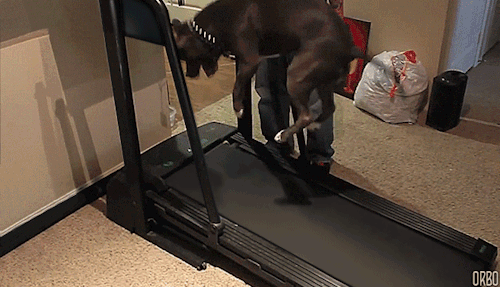
Giphy
January: The month where you can never seem to find an open elliptical or open treadmill at the gym because everyone is trying to work off their holiday weight as part of a New Year’s resolution. It’s a great idea, but if you’re anything like me, a New Year’s resolution doesn’t seem to last much longer than the length of January. This year I decided to be more conscious about exercising, and not just to do it when I feel like I’ve been lazy. It seems to be working so far, but the year is young.
I completely understand why it’s so easy for people to slack off from their resolutions to hit the gym more often, though. First, there’s the weather. If I hadn’t been on the softball team during my first Minnesota winter, not even the warmest pair of sweatpants would have motivated me to walk to the other side of campus to work out. Second, it’s crowded, and when it’s crowded at the gym, it takes longer to get a machine and finish a workout. We’re not made out of time, especially with classwork, tests, and actual jobs to do. So, if you’re wondering how to exercise in the winter without having to battle the weather and fight for machines at the gym, look no further than this list.
- Sign up for a PE class in the winter. Instead of forcing yourself to run, make yourself stick to a schedule by signing up for a class. Even if your school doesn’t have a PE requirement, it probably still offers physical education classes, or workout classes, each term. Try signing up for step aerobics, cycling, yoga, or modern dance. You want a class that gets you moving, but it doesn’t have to be a high intensity track and field class to fit the World Health Organization’s recommendation. If you’re taking the class for a grade, you’ll have extra incentive to be there each time it meets, and who doesn’t want an easy A? If you have to pay for it (and typically exercise classes at colleges are pretty cheap), you’ll have even more incentive to go!
- Join a winter IM team. The University of Michigan offers indoor soccer, basketball, pool basketball, and something called wallyball, which I can only assume is some offshoot of volleyball in the winter. At Carleton College, students can sign up to join a broomball team and play a sport that is kind of like ice hockey, except you wear tennis shoes and have brooms instead of sticks. Students at James Madison University can join basketball, dodgeball, racquetball, or indoor lacrosse leagues. There’s something for everyone, and you don’t have to be a pro to play intramural sports.
- Go ice skating, cross-country skiing, or snowshoeing. If you’re more the outdoorsy type, consider getting exercise outside. If you live somewhere where it snows, try cross-country skiing or snowshoeing. Cross-country skiing is a full body workout sure to leave you warm and exhausted at the end of the day. Snowshoeing is similar to walking, but since you’re walking through snow with something like a tennis racket tied to your feet, you get a bit more of a workout. The campus gym or recreation center may rent out skis and snowshoes to interested students, but check with them before you make any plans. You don’t want to show up in full winter gear only to be told that there isn’t any equipment available. Ice skating is probably the easiest winter sport to take part in, and it doesn’t depend on snow. Many towns have an indoor skating rink, and around the holidays outdoor rinks may also pop up. Both rent out skates if you don’t have your own. If it gets cold enough at your school, campus itself may even become home to a skating rink for a period of time.
- Run the stairs in your dorm. In the movies, athletes are always running the stairs at stadiums or, if you’re into Rocky, the steps of the Philadelphia Museum of Art. In the winter, stadiums have a tendency to get a bit icy, and you can’t run the museum steps if you’re not in Philly. You can, however, run the steps in an academic building (after classes are over for the day, please), your dorm, or elsewhere on campus. It’s basically a free StairMaster workout. You get cardio; your heart, lungs, and muscles have to work harder than on a flat run because you’re constantly changing elevation.

Rocky / Giphy
- Do YouTube workouts from the comfort of your bedroom. Try watching and following along with some of the videos uploaded by FitnessBlender. My personal favorite is this Booty Blaster Challenge, but they have dozens of videos featuring ab workouts, cardio, and even kickboxing. Most don’t require any equipment beyond a good pair of shoes. BeFit’s YouTube channel also offers dozens of quick workouts that you can do from the comfort of your dorm room floor. If you’re uncomfortable doing anything that is suggested in a video, you don’t have to do it, and you can always pause and take things at your own pace too. A quick Google search for “workout video” and the type of workout that you want will reveal hundreds of choices.
- Embrace the art of running outside in the cold. Instead of waiting for a treadmill, why don’t you just try running outside? Wear the right clothes; yes, you’ll get hot after you’ve been running for a bit, but you don’t want to end up with frostbite on your knees. Wear long sleeves, long pants, gloves, and a hat. If it’s really cold, wear two hats and throw on an extra jacket. If it’s snowing, sleeting, or raining, put on a waterproof layer so the cold doesn’t penetrate through your clothing. The first couple of breaths are going to be shocking, and your lungs probably won’t like it, but after you’ve hit your stride, you’ll be just fine!
- If you watch TV, use every commercial break to do quick exercises. Use commercial breaks to do crunches, jumping jacks, push-ups, or a set or all three. Instead of lazily sitting on your bed or couch for an hour, get up and get moving during the advertisements (and that way your Fitbit won’t buzz at you for being stagnant for too long). It’s not a hardcore cardio workout, but it’ll get your heart rate up for a few minutes at a time.
- Take a shot at swimming. Swimming is a great workout; just look at Katie Ledecky and Michael Phelps if you need proof. Most schools have an indoor pool on campus that can be used by students who aren’t on the swim team (though you might have restrictions on the times you can go). If you know how to swim, try working your way up to swimming at least half an hour of laps at a time and get your workouts in the water instead of on dry land. If you don’t know how to swim, sign up for an introductory swim class or swimming lessons through your school or the local YMCA. Swimming is a great option for those with achy joints, as it’s low-impact but still manages to work out every part of your body from your legs to your back.
You don’t have to go too far out of your way to get your workouts in during the winter. Depending on which activities you choose, you may have a blast and make new friends while also getting in shape. If you prefer to sweat in solitude, have at it! And good luck keeping those New Year’s resolutions.
-
How to Be Smart in Our National Parks This Summer
-
Why I Joined and Why I Quit: A Softball Story
-
How to Keep Your Brain Active Over Summer Vacation
-
Six Yoga Poses to Help with Anxiety and Panic Attacks
-
Yoga for Detoxing from the Weekend
-
Yoga: An Energizing Practice for Beginners
-
The Truth: Why You Should Get Fit to Finish the School Year
-
15 Ways to Avoid Gaining the Freshman 15
-
Easy Ways to Stay Fit When You’re Busy with School

